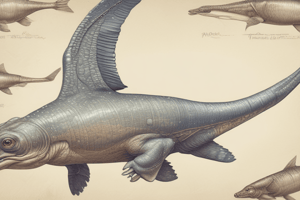Podcast
Questions and Answers
What major challenge do animals face when transitioning from water to land?
What major challenge do animals face when transitioning from water to land?
- Higher oxygen content in water
- Increased availability of food
- Lesser gravity on land
- Temperature regulation (correct)
Which group of amphibians makes up approximately 90% of all species?
Which group of amphibians makes up approximately 90% of all species?
- Caecilians
- Frogs and toads (correct)
- Salamanders
- Lungless salamanders
What process do aquatic larvae of amphibians undergo to lose their gills?
What process do aquatic larvae of amphibians undergo to lose their gills?
- Metamorphosis (correct)
- Transformation
- Adaptation
- Transfiguration
Which characteristic is true about amphibian skin?
Which characteristic is true about amphibian skin?
What is a common feeding habit of the majority of caecilians?
What is a common feeding habit of the majority of caecilians?
What structural adaptation do tetrapods require for support on land?
What structural adaptation do tetrapods require for support on land?
What does the term ectotherm refer to in amphibians?
What does the term ectotherm refer to in amphibians?
What typically characterizes the environment where most amphibians thrive?
What typically characterizes the environment where most amphibians thrive?
Amphibians migrated to land primarily to find more oxygen.
Amphibians migrated to land primarily to find more oxygen.
Caecilians belong to the order Gymnophiona and possess limbs.
Caecilians belong to the order Gymnophiona and possess limbs.
Frogs, salamanders, and caecilians make up the three major groups of modern amphibians.
Frogs, salamanders, and caecilians make up the three major groups of modern amphibians.
Modern amphibians maintain a constant body temperature regardless of environmental conditions.
Modern amphibians maintain a constant body temperature regardless of environmental conditions.
The skin of amphibians is thick and designed to protect against desiccation.
The skin of amphibians is thick and designed to protect against desiccation.
The process by which aquatic larvae of amphibians develop into adults is known as metamorphosis.
The process by which aquatic larvae of amphibians develop into adults is known as metamorphosis.
Amphibians have adapted to a variety of environments, with most thriving in very dry habitats.
Amphibians have adapted to a variety of environments, with most thriving in very dry habitats.
The majority of amphibian species lay eggs that hatch into aquatic larvae.
The majority of amphibian species lay eggs that hatch into aquatic larvae.
Study Notes
Vertebrate Diversity
- Phylum: Chordata; Sub-phylum: Vertebrata
- Significant focus on Class Amphibia, specifically Order Anura, Family Pipidae, Genus Xenopus, Species X. laevis
Origin of Tetrapods
- Early tetrapods transitioned to land primarily to avoid predators and exploit terrestrial food sources, such as arthropods.
- Challenges faced during this transition included:
- Oxygen Content: Air contains more oxygen, which diffuses more rapidly, crucial for survival.
- Fluid Density: Lack of buoyancy on land necessitated the development of strong limbs to counteract gravity.
- Temperature Regulation: Land experiences rapid temperature fluctuations, presenting harsh environmental conditions.
Modern Amphibians
- Three major groups of amphibians:
- Frogs (Anura or Salientia)
- Salamanders (Caudata or Urodela)
- Caecilians (Apoda or Gymnophiona)
- Approximately 7,600 species of amphibians, with frogs and toads constituting about 90% of this number.
- Most amphibians lay eggs in aquatic environments, leading to the hatching of larvae that use gills for respiration before undergoing metamorphosis to lose their gills.
Characteristics of Amphibians
- Amphibians possess thin skin that requires moisture to prevent desiccation.
- They are ectothermic, meaning their body temperature aligns with environmental temperatures, thriving in moist, cooler habitats.
- Global amphibian species richness illustrates significant diversity across various ecosystems.
Caecilians
- Order Gymnophiona (Apoda) includes around 200 species.
- Characterized by long, slender bodies with numerous vertebrae, long ribs, and absence of limbs; some species feature small dermal scales.
- Eyes are typically small, with many species being completely blind as adults, predominantly feeding on earthworms and small insects.
Vertebrate Diversity
- Phylum: Chordata; Sub-phylum: Vertebrata
- Significant focus on Class Amphibia, specifically Order Anura, Family Pipidae, Genus Xenopus, Species X. laevis
Origin of Tetrapods
- Early tetrapods transitioned to land primarily to avoid predators and exploit terrestrial food sources, such as arthropods.
- Challenges faced during this transition included:
- Oxygen Content: Air contains more oxygen, which diffuses more rapidly, crucial for survival.
- Fluid Density: Lack of buoyancy on land necessitated the development of strong limbs to counteract gravity.
- Temperature Regulation: Land experiences rapid temperature fluctuations, presenting harsh environmental conditions.
Modern Amphibians
- Three major groups of amphibians:
- Frogs (Anura or Salientia)
- Salamanders (Caudata or Urodela)
- Caecilians (Apoda or Gymnophiona)
- Approximately 7,600 species of amphibians, with frogs and toads constituting about 90% of this number.
- Most amphibians lay eggs in aquatic environments, leading to the hatching of larvae that use gills for respiration before undergoing metamorphosis to lose their gills.
Characteristics of Amphibians
- Amphibians possess thin skin that requires moisture to prevent desiccation.
- They are ectothermic, meaning their body temperature aligns with environmental temperatures, thriving in moist, cooler habitats.
- Global amphibian species richness illustrates significant diversity across various ecosystems.
Caecilians
- Order Gymnophiona (Apoda) includes around 200 species.
- Characterized by long, slender bodies with numerous vertebrae, long ribs, and absence of limbs; some species feature small dermal scales.
- Eyes are typically small, with many species being completely blind as adults, predominantly feeding on earthworms and small insects.
Studying That Suits You
Use AI to generate personalized quizzes and flashcards to suit your learning preferences.
Description
This quiz focuses on the diversity of vertebrates, particularly examining amphibians and their classification within the Phylum Chordata. Students will summarize key learnings from recent classes, emphasizing the characteristics of various vertebrate classes including Amphibia, Reptilia, Aves, and Mammalia. Dive into the fascinating world of early tetrapods and modern amphibians.




